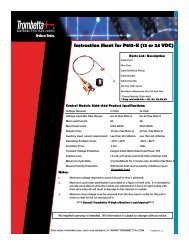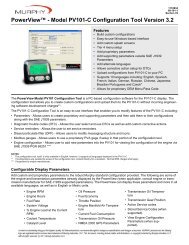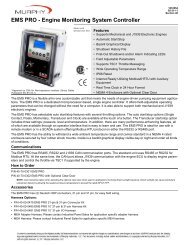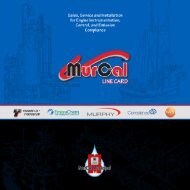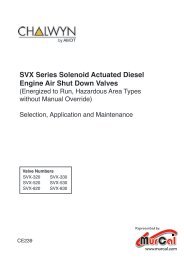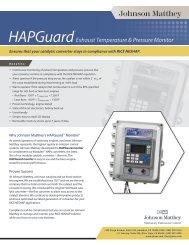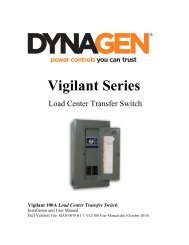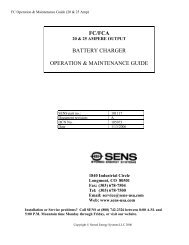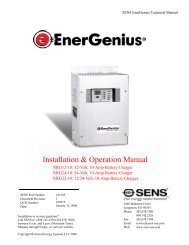Johnson Matthey - Emission Control Technologies
Johnson Matthey - Emission Control Technologies
Johnson Matthey - Emission Control Technologies
You also want an ePaper? Increase the reach of your titles
YUMPU automatically turns print PDFs into web optimized ePapers that Google loves.
Team up with the global leader inemissions control for hassle-freemanagement of your RICE NESHAPrequirements.As owner/operators of stationary engines, you know <strong>Johnson</strong><strong>Matthey</strong> represents the highest quality in emissions controlsystems. We strive to ensure that your engines operate at peakefficiency while complying with more and more stringentenvironmental standards for air quality.That includes the EPA’s RICE NESHAP regulation which becomeseffective in 2013.We offer you the latest generation of <strong>Johnson</strong> <strong>Matthey</strong> ModulexTM HAPs catalytic converter/silencers, and the HAPGuard TMexhaust monitor, as well as technical support, to ensure compliancewith RICE NESHAP.Compliance can be complicated, but you can count on <strong>Johnson</strong><strong>Matthey</strong> to manage your emission solution while youfocus on your core business.About RICE NESHAPThe first RICE NESHAP (Reciprocating Internal CombustionEngine National <strong>Emission</strong> Standards for Hazardous Air Pollutants)regulation was enacted in 2004 for existing >500 Hp gasengines at major pollution sources. The EPA’s 2008 RICENESHAP affected new engines.The 2010 RICE NESHAP (40 CFR Part 63, Subpart ZZZZ) setslimits for emissions of formaldehyde, acetaldehyde, acrolein,methanol and nearly 200 other toxic compounds from stationarydiesel and gas engines, focusing on formaldehyde as theregulated emission.However, the EPA has determined that carbon monoxide (CO)is an appropriate surrogate for formaldehyde. Since testingfor CO has many advantages over testing for HAPs most of theemission standards have been finalized using CO as the onlyregulated pollutant.The vast majority of existing stationary engines are regulated insome fashion by the 2010 RICE NESHAP. These engines must bein compliance by:• Non-Emergency Diesel (CI) Engines by May 13, 2013.• Non-Emergency Gas (SI) Engines by October 13, 2013.The startup, shutdown and malfunction (SSM) requirementsfor RICE NESHAP have been in effect since 2010. Existingemergency stationary RICE located at residential, institutional,or commercial area sources of HAPs emissions are exempt fromthe 2013 requirements.The 2010 RICE NESHAP is summarized in Table 1.Table 1: RICE NESHAP for Existing Stationary Gas and Diesel EnginesGas Engine Standards (effective October 2013)Type of Engine100 to 500 Hp Non-EmergencyEngine Located at Major Sources> 500 Hp that Operate > 24 Hrs/Yr Located at New/Reconstucted/Existing Major Source or Existing Area Sources2SLB (2-stroke lean burn) 225 ppmvd CO @ 15% O2 No MACT std. due to insufficient data4SLB (4-stroke lean burn) 47 ppmvd CO @ 15% O2 47 ppmvd CO @ 15% O2 or 93% CO reduction4SRB (4-stroke rich burn) 10.3 ppmvd formaldehyde @ 15% O2 2.7 ppmvd formaldehyde @ 15% O2 or 76% formaldehydereduction or 350 ppbvd formaldehyde @ 15% O2Landfill/digester gasAfter treatment177 ppmvd CO @ 15% O23-way (NSCR) for rich burn engines and 2-way (oxidation catalyst) for lean burn enginesDiesel Engine Standards (effective May 2013)Engine Size Non-Emergency Engines Located at Major Sources Non-Emergency Engines Located at Area Sources100 to 300 Hp 230 ppmvd CO @ 15% O2300 to 500 Hp 49 ppmvd CO @ 15% O2 or 70% reduction 49 ppmvd CO @ 15% O2 or 70% reduction> 500 Hp 23 ppmvd CO @ 15% O2 or 70% reduction 23 ppmvd CO @ 15% O2 or 70% reductionAfter treatmentBurn ULSD and install DOC on non-emergency engines with a site limit of > 300 HpMajor Source: Any stationary source or group of stationary sources located within a contiguous area and under common control emits or has the potential to emit considering controls, in the aggregate ≥ 10 TPY ofa single HAP or ≥ 25 TPY of two or more HAPs.Area Source: Not a major source | EPA estimates there are > 900,000 stationary CI engines installed | EPA estimates there are > 330,000 stationary SI engines installed.Date Applicability: Engines >500 HP at major source: Existing if constructed before Dec. 19, 2002 | New if constructed on or after Dec. 19, 2002 | Reconstructed if reconstruction began after Dec. 19, 2002.Engines ≤500 HP at major source of HAP and engines of all HP at an area source of HAP: Existing if constructed before June 12, 2006 | New if constructed on or after June 12, 2006 | Reconstructed if reconstructionbegan after June 12, 2006.<strong>Johnson</strong> <strong>Matthey</strong> Stationary <strong>Emission</strong>s <strong>Control</strong> Modulex TM Catalytic Converters / 3
HAPGuard TM Exhaust Temperature & Pressure MonitorEnsures that your catalytic converter stays in compliance withRICE NESHAPOur innovative HAPGuard TM exhaust temperature and pressuremonitor alerts you if the catalyst inlet temperature is out of theEPA-specified ranges for rich burn and lean burn engines:• Rich Burn: 750°F < T Catalyst Inlet < 1250°F• Lean Burn: 450°F < T Catalyst Inlet < 1350°FIt also warns you if the pressure drop across the catalyst is notwithin 2” w.c. of the value established during initial testingat 100% load. The HAPGuard TM monitor is engine tested andproven effective.HAPGuard TM Monitor.Table 4: HAPGuard TM FunctionalityDisplayed onHMI Screen Factory Set Points User Configurable Datalogged*MeasuredPre-DOC temperature (-328°F to +2282°F) Yes N/A N/A YesPre-DOC pressure (0 to 100” w.c.) Yes N/A N/A YesPost-DOC pressure (0 to 100” w.c.) Yes N/A N/A YesCalculated ValuesDifferential pressure (”w.c.) Yes N/A N/A YesEngine runtime (min.) Yes N/A N/A totalized on screen4-hour rolling average temperature (°F) Yes N/A N/A YesInitial DP set point (”w.c. w/engine @ 100%) Yes N/A Yes NoWarnings4-hour rolling average temperature out of range Yes 450°F < temp., NoYes< 1250°FDifferential pressure out of range (”w.c.) Yes plus/minus 2” w.c.of baselineNoYes* At least 2 years of data will be stored.Chart 2: HAPGuard TM Monitor Technical SpecificationsPower Supply• Input voltage: 24VDC• Permissible range: 20.4VDC to 28.8VDC with less than 10% rippleGraphic Display Screen• LCD type: STN, LCD display• Illumination backlight: white LED, software-controlled• Display resolution: 128 x 64 pixels; viewing area 2.4”Keypad• Key type metal dome, sealed membrane switch; 20 keysRemovable Memory• Micro SD card: data logged at 5-min. intervals with up to 5 years of datastorage capacity; export .csv files to ExcelMiscellaneous• Real-time clock functions (date and time)• Battery replacement: coin-type 3V, lithium battery, CR2450Weight/Dimensions• Weight: 2.27 kg (5.0 lbs.)• Size: 240 x 223 x 150mm (9.52 x 8.85 x 5.95”)Environment• Operational temperature: 0 to 50ºC (32 to 122ºF)• Storage temperature: –20 to 60ºC (–4 to 140ºF• Relative humidity: (RH) 10% to 95% (non-condensing)Mounting Method• Panel mount IP65 rated enclosure<strong>Johnson</strong> <strong>Matthey</strong> Stationary <strong>Emission</strong>s <strong>Control</strong> Modulex TM Catalytic Converters / 7



